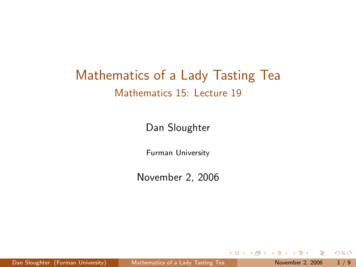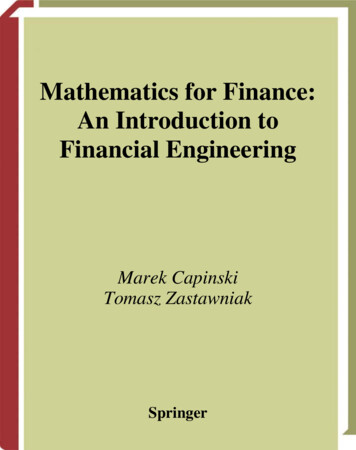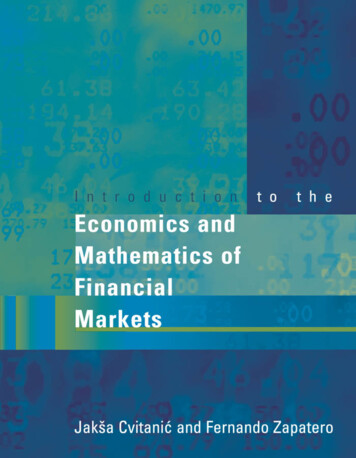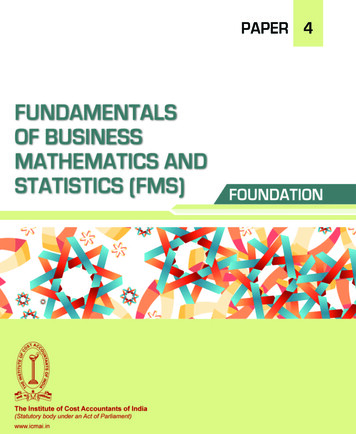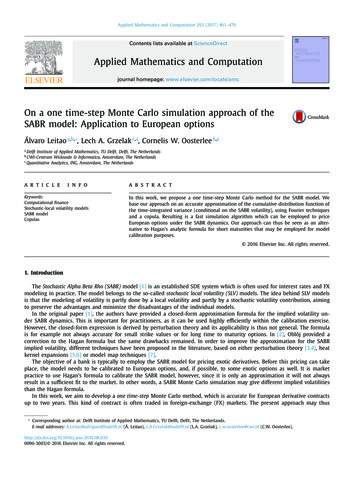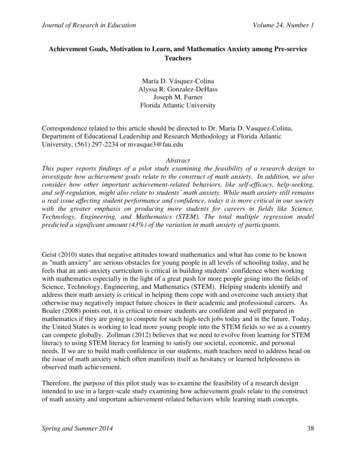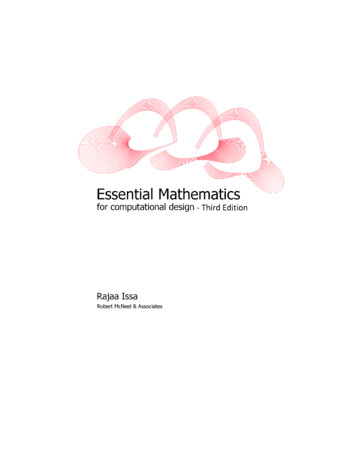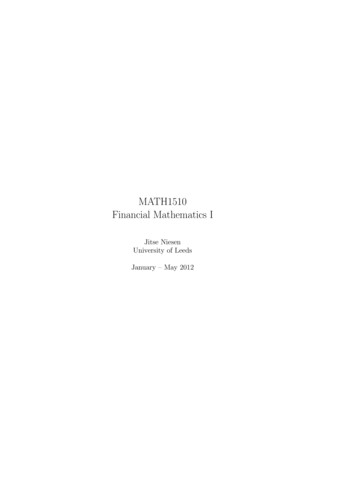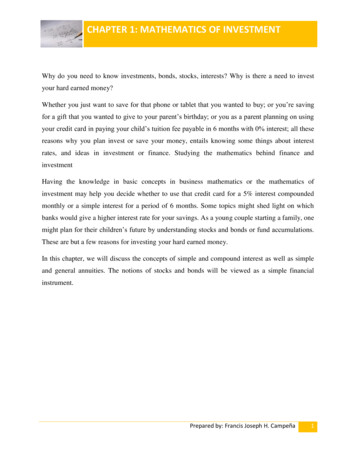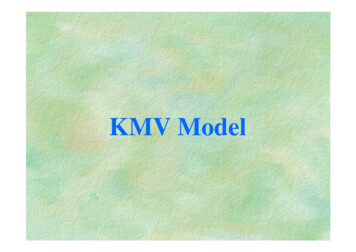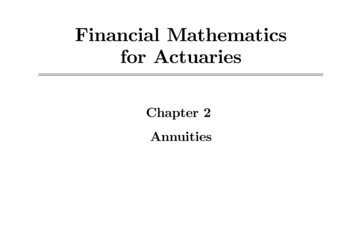
Transcription
INTRODUCTION TOBUSINESS MATHEMATICSUnits: 1–9Code: 1349DEPARTMENT OF MATHEMATICSFACULTY OF SCIENCESALLAMA IQBAL OPEN UNIVERSITYi
(All Rights are Reserved with the Publisher)Year of Printing. 2020Quantity. 5000Price . Rs.Printing Incharge . Shakil Ahmad KhanPrinter. AIOU-Printing Press, H-8, Islamabad.Publisher . Allama Iqbal Open University, Islamabadii
COURSE DEVELOPMENT TEAMDean Faculty of Sciences:Prof. Dr. Syed Zafar IlyasDevelopment Coordinator:Dr. Nasir RehmanWriters:1. Dr. Nasir Rehman2. Ms. Fouzia Rehman3. Ms. Mubashra HafeezReviewers:1. Dr. Nasir Rehman2. Dr. Babar Ahmad3. Ms. Fouzia RehmanEditor:Mr. Fazal KarimCourse Coordinator:Ms. Fouzia RehmanComposed by:Ms. Mubashra Hafeeziii
CONTENTSPage No.Foreword .vMessage from the Dean . viAcknowledgments. viiCourse Introduction . viiiUnit-1: Business Arithmetic-I .01Unit-2: Business Arithmetic-II .15Unit-3Mathematics of Finance-I .29Unit-4Mathematics of Finance-II .39Unit-5 Linear, Quadratic and Simultaneous Equations .51Unit-6 Functions and Their Graphs .67Unit-7 Elements of Matrix Algebra-I .93Unit-8 Elements of Matrix Algebra-II .120Unit-9 Binary Number System and Its Operations .140Bibliography .152iv
FOREWORDMathematics plays a vital role in the logical development of any society. Thatis why it serves as an essential subject during the early ages of all students. Tomake the best use of our available resources, we must have a betterunderstanding, knowledge and practice of mathematics. This is very vastsubject and ranges from some abstract ideas to purely applied concepts.The present book has been written to understand the basic concepts ofmathematics and its applications in issues related to Business, Economics,Commerce and many other Social Sciences. This book with its simple textstyle serves as the first step for students who aim to get an introduction of thesubject. Keeping in mind the objectives of the book, I am sure it will providean insight into the subject along with enhancing the mathematical abilities ofthe students. Moreover, it is especially written to help students learn theapplications of relevant mathematical concepts.In the end I would like to congratulate the course team, chairman, coursedevelopment coordinator, writers, reviewers and editor for developing a veryuseful textbook.Prof. Dr. Zia Ul-Qayyum(Vice-Chancellor)v
MESSAGE FROM THE DEANMathematics is the branch of science which develops a relationship and fills thegaps between the natural sciences. Naturally mathematics looks a bit abstract, butwhen we use it in other sciences. Its applications come across to us at once. Thiscourse is much needed for our students to inculcate the first-level concepts. Thebasic mathematics needed for Business and other social sciences subjects isbeautifully covered in this book.I wish to express my sincere thanks, appreciation and congratulations to all thosepersons who have contributed in the development of this book. I am sure this willbe very beneficial to our students to groom their business ideas mathematically.(Prof. Dr. Syed Zafar Ilyas)Dean Faculty of Sciencesvi
ACKNOWLEDGFMENTSFirst and foremost, I would like to thank Allah that I have been able to present this book.I deeply indebted to all who have contributed either directly or indirectly in producingthis book.My deep and sincere thanks to Chairman, Department of Mathematics, AIOU, Dr. NasirRehman who encouraged and directed me. It is with his direction that this work came intoexistence. I would like to thank my colleagues Dr. Irfan Mustafa, Dr. MuhammadNazam, Mr. Faisal Iqbal, Mr. Muhammad Aatif and Ms. Mubashra for their constantsupport and encouragement. I am especially grateful to Dr. Babar for his extremelydetailed reviews and suggestions of the manuscript many times till the finalization of thisbook. Many extraordinary talented are responsible for helping to create this text.I would like to thank Ms. Mubashara for typing and editing this course on priority basis. Iam highly grateful to Prof. Dr. Zia ul Qayyum, Vice-Chancellor AIOU and Prof. Dr.Syed Zafar Ilyas, Dean Faculty of Sciences AIOU for giving creative ideas of writingdifficult mathematical concepts in a simple way and provided all facilities to completethis course in the shortest possible time.Suggestions and criticism to improve the text will be highly appreciated.(Ms. Fouzia Rehman)Course Coordinatorvii
COURSEINTRODUCTIONBasic idea is to develop and inculcate the important concepts needed for the study ofBusiness Mathematics in our students at undergraduate level. An effort has been made tomake these contents self-explanatory and understandable. It is the need of hour tounderstand the applications of Mathematics in studying different subjects of socialsciences and other fields too.OBJECTIVESThe course aims to teach students, the basic concepts of Mathematics and also createvalue for their applications and uses in practical situations.The objectives of the course are: To develop an understanding and desire of Mathematics in students To present the material in a way which is helpful in motivating the students to studythese subjects at a higher level To develop an approach of application of Maths in business subjectsHow the course is organized?The text is divided into nine units in one volume. An attempt has been made to presentthe material in an informal way. Only those topics of Mathematics are covered which arethought to be useful for everyone. e.g. we started studying Mathematics when we were inclass one and we continue its studies. In spite of this, most of us do not have fullcommand on every day arithmetics.Unit-1 Unit 1 covers the idea of Rate with Ratio and how they can be expressed inpercentage form also applied these concepts on business related problems.Unit-2 Unit 2 explains the concept of Profit, Revenue, Cost and Depreciation. Twodifferent methods to charge depreciation are also discussed in this chapter.Unit-3 Unit 3 is concerned with interest rates and their effects on the value of money.Unit-4 Unit 4 discusses the concept of annuity and its types. Apply this concept onvarious business related problems.Unit-5 In Unit 5, is about the introduction of equations and their uses in the solution ofdifferent practical problems. Nature of solution of First degree, second degreeand simultaneous linear equations are also discussed in this unit.Unit-6 In this unit the concept of a function is discussed which is the fundamentalmathematical object which is used to describe relationship between variablequantities. Different types of functions and their graphs are also explained inthis unit.Unit-7 Unit 7 explains the term matrix and its different types with and without takingchange in the matrix.Unit-8 This unit explains the different operation on matrices and its application in business.Unit-9 Unit 9 This unit explains the binary number system. This is the language thatmost of the electronic devices understand. Arithmetic operation on Binarynumber and relationship between binary and decimal number system are alsoexplained in this unit.viii
Unit–1BUSINESS ATHMETIC – IWritten By: Mubashara HafeezReviewed By: Ms Fouzia Rehman1
CONTENTSPage #Introduction . 3Objectives . 31.1Ratio . 41.1.1 Rate . 41.1.2 Use of Ratio . 51.2Proportion . 71.2.1 Types of Proportion. 7(i) Direct Proportion . 7(ii) Inverse Proportion . 8(iii) Compound Proportion . 9(iv) Continued Proportion . 91.3Percentage . 101.3.1 Conversion of a Percentage into a Fraction . 101.3.2 Conversion of a Percentage into Decimal . 111.3.3 Business Applications of Percentage . 111.4Self-Assessment Questions. 122
INTRODUCTIONThe word arithmetic is from the Greek word arithmos it is a branch of mathematics whichdeal with the study of numbers. Mathematics used in marketing, accounting, salesforecasting, inventory management and financial analysis. Mathematics typically used incommerce includes arithmetic. Arithmetic is not only frequently use in statistics andmathematics but also use in various fields such as history, sociology and economics. Forexample, per capita income is the arithmetic mean income of a nation's population.In this unit students will be able to learn about.1.The concept of ratio and rate2.Types of proportions3.The concept of percentage and conversion of percentage into fraction and decimal4.Applications of percentageOBJECTIVESAfter studying this unit, students will be able to:1.differentiate between ratio and rate2.apply these concepts to solve practical problems related to business mathematics3.understand the business applications of percentage3
1.1 RATIORatio indicates the relationship how one quantity is of the other. For example if 𝑥𝑥 and𝑦𝑦 are two quantities and both are in same unit we need to compare these two quantitieswe can write it as 𝑥𝑥/𝑦𝑦 is known as 𝑥𝑥 ratio 𝑦𝑦.Ratio can be defined as the contrast of two or more quantities that have same unit it isalways a constant number and it is free from unit of measurement. In ratio sum offractional part is always equal to 1. Ratio is basically comparison. It is denoted as :symbolically ratio between two quantities can be written as 𝑥𝑥: 𝑦𝑦.Continued RatioRatio of three quantities i.e. 𝑎𝑎: 𝑏𝑏: 𝑐𝑐 is known as continued ratio if ratio of 𝑎𝑎: 𝑏𝑏 and 𝑏𝑏: 𝑐𝑐is given.To calculate the continued ratio there must be one similar element in both quantities. If thereis no similar element in both quantities, then we make it similar by multiplying bothquantities with different to make some common element in both quantities to get the result.Example 1:Calculate the continued ratio 𝑎𝑎: 𝑏𝑏: 𝑐𝑐 when 𝑎𝑎: 𝑏𝑏 5: 6 and 𝑏𝑏: 𝑐𝑐 6: 7Solution:We can see that in the given problem the common quantity is 𝑏𝑏:𝑎𝑎 𝑏𝑏 𝑐𝑐5 66 7Hence 𝑎𝑎: 𝑏𝑏: 𝑐𝑐 5: 6: 75 6 71.1.1 RateThe only difference between the ratio and rate is, rate is not free from unit ofmeasurement. If 𝑥𝑥 and 𝑦𝑦 are two uniform information and both have different units thenthe ratio "𝑎𝑎/𝑏𝑏" is known as rate.Representation of Rate and RatioThere are three ways to present rate and ratio.1.Fraction form: Ratio and rate can be written as in form of fraction i.e.and 𝑞𝑞 are real numbers and 𝑞𝑞 0.4𝑝𝑝𝑞𝑞where 𝑝𝑝
2.3.Decimal form: In decimal form ratio and rate can be written as:1000 1𝑅𝑅𝑅𝑅. 1000 𝑅𝑅𝑅𝑅. 2000 0.52000 2Percentage form: The percentage form of ratio and rate is:𝑅𝑅𝑅𝑅. 1000 𝑅𝑅𝑅𝑅. 2000 1.1.2 Use of Ratio1000 11 100 50%2000 2100 1 % 100In financial analysis ratio analysis is the one of the most powerful tool to interpret thedata.The ratio analysis used in supplier of goods on credit, banks, financial institutions,investors, shareholders and management as a tool to evaluate the financial position and tocheck the performance of the firm. How the firm granting credit, providing loans ormaking investment in the firm we can check it by calculating the ratio.Ratio also use to examine the blood pressure, pulse rate, and the temperature of theindividual which helps the doctor to make his conclusion regarding the illness.Ratio also use to calculate tax and audit requirements, utility to government, utility toemployees, utility to shareholder and investors and for many other purposes.Example 2:Convert the given ratio 30: 360 into its simplest form.Solution:Given ratio is 30: 360Fraction form isHence the ratio of 30 and 360 is 1: 12130 360 12Example 3:Cash price distributed between two students in the ratio of 4: 5 is Rs. 900. Calculate theamount that each student received.Solution:Distributed amount is Rs. 9005
According to the condition of the given questionLet ratio between two students 𝑋𝑋 and 𝑌𝑌 is 4: 5Sum of the given ratio 4 5 9Fractional part of student 𝑋𝑋 Fractional part of student 𝑌𝑌 495949Student 𝑋𝑋 will receive 900 𝑅𝑅𝑅𝑅. 40059Student 𝑌𝑌 will receive900 𝑅𝑅𝑅𝑅. 500Check whether the sum of fractional part is equal to 1495999Sum of fractional parts 1Example 4:Manager of particular firm is earning 𝑅𝑅𝑅𝑅. 200,000 per month as salary and his per monthspending are Rs. 190,000. One of the assistants of the same manager earning Rs. 40,000per month and his per month saving is Rs. 8000. As regard to their income who is savingmore?Solution:Manager’s monthly income 𝑅𝑅𝑅𝑅. 200,000His monthly spending’s 𝑅𝑅𝑅𝑅. 190,000His monthly saving 𝑅𝑅𝑅𝑅. 200,000 𝑅𝑅𝑅𝑅. 190,000 𝑅𝑅𝑠𝑠. 10,0001 20Ratio between saving and income 10,000 200,000 1: 20 Assistant’s monthly income 𝑅𝑅𝑅𝑅. 40,000His monthly saving 𝑅𝑅𝑅𝑅. 800015100 % 5%Ratio between saving and income 8000 40,000 1: 5 100 % 20%Hence we can see that saving-income ratio of manager and subordinate are 5% and 20%repectively.6
Which shows that manager’s subordinate is saving more regarding his income.1.2 PROPORTIONWhen two ratios are equal we named it as proportion. It is denoted as " " or " ".For example2 8 8 32 this proportion is read as 2 is to 8 is equal to 8 is to 32.In every proportion there are always 4 terms the 1st and 4th terms are called extremes andtheir product is called product of extremes while the 2nd and 3rd terms are called meansand their product is called product of means.To find the proportion we use the ��𝑃𝑃𝑃 𝑜𝑜𝑜𝑜 ��𝑒𝑒𝑒 ��𝑃 𝑜𝑜𝑜𝑜 𝑚𝑚𝑚𝑚𝑚𝑚𝑚𝑚1.2.1 Types of ProportionThere are four types of proportion:i.ii.iii.iv.Direct proportionInverse proportionCompound proportionContinued proportion(i)Direct ProportionWhen two quantities are directly related to each other i.e. increase in one quantitycause the increase in other quantity and the decrease in one quantity cause thedecrease in other quantity this is known as direct proportion.For example, the amount of electric bill is directly proportional to the number ofunits used. If more electric units are used, then the amount of bill is greater and ifthe less electric units are used then the amount of bill is less.Example 5:If the cost of 20 dozens of eggs is 𝑅𝑅𝑅𝑅. 200. Find the cost of 4 dozens of eggs.Solution:According to the given condition of the question we have:𝐸𝐸𝐸𝐸𝐸𝐸𝐸𝐸 (𝑖𝑖𝑖𝑖 𝑑𝑑𝑑𝑑𝑑𝑑𝑑𝑑𝑑𝑑𝑑𝑑) 20 4 7𝐶𝐶𝐶𝐶𝐶𝐶𝐶𝐶 (𝑖𝑖𝑖𝑖 𝑅𝑅𝑅𝑅. )200𝑥𝑥
Quantity of eggs and cost are in direct proportion less the quantity lower the cost. Wherethe head of the arrow shows the denominator value and tail shows numerator value.20 4 200 𝑥𝑥4𝑥𝑥 20200Applying the cross multiplication4 20020𝑥𝑥 40𝑥𝑥 Hence the cost of 4dozens eggs is 𝑅𝑅𝑅𝑅. 40(ii)Inverse ProportionIf two quantities are related to each other in a way that increase in one quantitycauses the decrease in other and the decrease in one quantity cause the increase inother quantity this relation is known as inverse proportion.For example, if a person is traveling and wants to cover the distance in the less timefaster the speed of car less time is required to cover the distance.Example 6:If 30 labors are required to construct a building in 90 days. How many labors arerequired to construct the building in 45 days?Solution:According to the given condition of the question𝐿𝐿𝐿𝐿𝐿𝐿𝐿𝐿𝐿𝐿30 𝐷𝐷𝐷𝐷𝐷𝐷𝐷𝐷 45 𝑥𝑥90We can observe that from the above table that smaller the days more labors are requiredto finish the work which shows the inverse proportion.30 𝑥𝑥 𝑥𝑥 𝑥𝑥 30𝑥𝑥90 45904590 3045 608
(iii) Compound ProportionIn some cases, we need to deal with more than one proportion this mutual relationof proportion in such cases is known as compound proportion.Example 7:With the help of 40 workers a manufacturer decides to produce 200 units. Workers work6 hours in a day. If 60 workers can work 4 hours in a day then how many units they ��𝑊𝑊𝑊𝑊𝑊𝑊4060Now we calculate for 𝑦𝑦.Cross multiplication ��𝑊 ℎ𝑜𝑜𝑜𝑜𝑜𝑜𝑜𝑜 𝑈𝑈𝑈𝑈𝑈𝑈𝑈𝑈𝑈𝑈 6 56040 200𝑦𝑦6𝑦𝑦 5200 𝑦𝑦605 200406𝑦𝑦𝑦𝑦Hence 250 number of units are produced.(iv) 5 2004250Continued ProportionContinued proportion is when first term of proportion is related to the second term ofproportion and second term of proportion is related to third term and so on i.e. there is thecontinuity in the following proportion. In continued proportion denominator should benot equal to zero.𝑝𝑝 𝑞𝑞 𝑥𝑥 𝑞𝑞 𝑥𝑥 𝑦𝑦9
Example 8:Three partners of a company Mr. Asad, Mr. Ali and Mr. Ahmed earned profit of𝑅𝑅𝑅𝑅. 24000. In terms of ratio the profit that can be shared is𝑋𝑋 𝑌𝑌 4 5 𝑎𝑎𝑎𝑎𝑎𝑎 𝑌𝑌 𝑍𝑍 10 6Find the profit share of each partner.Solution:Total amount of profit 24000Ratios:𝑋𝑋 𝑌𝑌 𝑍𝑍4 510 40 50 30Dividing by 10 we getSum of the ratio 4 5 3 12Mr. Asad’s share in profitMr. Ali’s share in profit Mr. Ahmed’s share in profit 1.3 PERCENTAGE64 125 126124 5 324000 800024000 10000 24000 12000Percentage is defined as a number or ratio written in a fraction of 100 it is denoted as %.Percentage is a real number it has no dimension or unit.Percentage can be written into either fractional or as a decimal number.1.3.1 Conversion of a Percentage into a FractionRemove the sign of given percentage and divide it by the 100 and then simplified thefraction into its smallest term i.e.10
20% 2021 100 10 51.3.2 Conversion of a Percentage into DecimalFirstly remove the sign of percentage then divided by 100 and move the decimal pointtwo places from left i.e.20% Example 9:20 0.20100Convert 225% into a fraction and decimal.Solution:Conversion of percentage into fraction:225% 225 9 100 4Conversion of percentage into decimal, move the decimal two digits from left.Example 10:225% 225 2.25100Calculate 25% of 𝑅𝑅𝑅𝑅. 1500.Solution:First step is to replace 25% by25100and here “of” indicates the sign of multiplication ( )𝑥𝑥 25 1500100𝑥𝑥 𝑅𝑅𝑅𝑅. 3751.3.3 Business Applications of PercentageExample 11:A cricket team won 84% of 150 matches in a season. How many matches is that?Solution:The mathematical form of the given problem is:11
What is 84% of 150Hence team won 126 matches.𝑥𝑥 84 150100𝑥𝑥 126Example 12:Fahad has 𝑅𝑅𝑅𝑅. 500 and he spend 35. What percent of his money is spent?Solution:Total money 𝑅𝑅𝑅𝑅. 500He spend 𝑅𝑅𝑅𝑅. 35Let 𝑥𝑥% of his money is spent35 𝑥𝑥% 50035 𝑥𝑥 50010035 𝑥𝑥 5Hence 7% of his money is spent.𝑥𝑥 71.6 SELF-ASSESSMENT QUESTIONSQ# 1. Fill in the Blanksi.Expressing a quantitative relationship between two quantities is .ii.Ratio can reduce the quantity into .term.iii.The lowest term of ratio 150 350 is .iv.Proportion can be denoted as .v.Two ratios are .in proportionvi.The external terms proportion is known as .and middle term is knownas .vii.Two quantities are directly related to each other in .proportion.12
viii. 22% in decimal is .ix.Percentage can be converted into .and .x.50 in percentage is .Q # 2. Choose the Correct Answeri.Ratio should be reduced to . terma) Equalb) Lowestc) Highestd) noneii. For the quantities 𝑥𝑥, 𝑦𝑦 and 𝑧𝑧 the two ratios 𝑥𝑥: 𝑦𝑦 and 𝑦𝑦: 𝑧𝑧 are given then the ratio𝑥𝑥: 𝑦𝑦: 𝑧𝑧 is called .a) Continued Ratiob) Compound Ratioc) Proportion d) Ratioiii. Two ratios that are equal and linked by the sign of " " or " " are known asa) Ratiob) Proportionc) both a and bd) noneiv. Simplify 20: 120a) 2: 10b) 10: 20c) 2: 6d) 1: 6v. Product of middle term of proportion is known as .a) Product of extremesb) Product of meanc) Product of middle ratiod) both a and bvi. In direct proportion two terms are .related to each othera) Inverselyb) Indirectlyc) Directlyd) Notvii. Meaning of percent is .a) Hundredthsb) Thousandsc) Ten Thousands d) Ten Hundredthsviii. Percentage is a .numbera) Complexb) Real c) It can be both a and bd) noneix. In continued proportion denominator should not be equal to .a) Numeratorb) Onec) Zerod) Allx. 280 is what percent of 20000?a) 1.7%b) 1.6%c) 1.5%d) 1.4%Q # 3. True/ Falsei.ii.iii.iv.v.vi.vii.viii.ix.x.In ratio the total of fractional part is always equal to 1.Ratio is denoted as and proportion is denoted as :Ratio between 240: 360 is 2: 3.Rate is free from unit of measurement.There are three ways of presenting rate and ratio.Proportion have five types.2: 6 𝑦𝑦: 36 where 𝑦𝑦 12.45% of 455000 is 204750.In inverse proportion if one quantity is increasing then other is also increasing.In compound proportion we only deal with one proportion.13T/FT/FT/FT/FT/FT/FT/FT/FT/FT/F
Q # 4. Solve the Following QuestionsDivide Rs. 80000 in the ratio 2: 61Write : 200 in the simplest form20Rs. 5,00,000 profit is earned from business by four partners. This profit is to beallocated to the four partners in the ratio 5: 8: 9: 3. Determine the amount of profitof each.iv. Express 58.5% to a common fraction.v.Solve for 𝑥𝑥 in each case 4 8 𝑥𝑥 50 and 2 40 10 𝑥𝑥vi. The height of a building A is 30 feet and its shadow is36 feet. If the height of abuilding B is 40feet then how long a shadow would be?vii. If 𝑅𝑅𝑅𝑅. 3000 is the price of three suits of five meters in the amount of 𝑅𝑅𝑅𝑅. 8000 howmany suits, can be purchased? Also find the price of cloth per meter.viii. A car runs 60 km in 5 liters of petrol. If tank is full of 20 liters, how far will itcover the distance?1ix. Convert 77.87% and 24 % into decimal and common fraction.5x.A person spend80% of his/her income and saves 𝑅𝑅𝑅𝑅. 600. What is his/her totalincome?i.ii.iii.14
Unit–2BUSINESS ARITHMETIC – IIWritten By: Mubashara HafeezReviewed By: Dr Nasir Rehman15
CONTENTSPage #Introduction . 17Objectives . 172.1Discount. 182.1.1 Absolute Term . 182.1.2 Relative Term . 182.1.3 Mathematical Formula for Discount . 182.1.4 Stated Price . 182.1.5 Discounted Price . 182.1.6 Successive Discount . 192.1.7 Quantity Discount . 202.2Commission or Brokerage . 212.3Profit and Loss . 212.3.1 Percentage Ratio of Profit and Cost . 222.3.2 Percentage Ratio of Loss and Cost . 222.3.3 Profit and Loss Based on Selling Price . 232.4Depreciation. 242.4.1 Method to Charge Depreciation . 242.4.1.1 Fixed Installment or Straight Line or Original Cost Method . 242.4.1.2 Diminishing Balance or Reducing Balance Method . 242.5Self-Assessment Questions. 2616
INTRODUCTIONArithmetic is the branch of mathematics that deals with numbers. Mainly the propertiesof the traditional operations on them multiplication, addition, division, exponentiation,subtraction and extraction of roots. Arithmetic is not only frequently use in statistics andmathematics, but also use in various fields such as history, sociology and economics. Forexample, per capita income is the arithmetic mean income of a nation's population.In this unit students will be able to learn about:1.The concept of discount and mathematical formula for discount.2.Commission and breakage.3.The concept of profit and loss.4.The percentage ratio of profit and cost and percentage of loss and cost.5.The definition of depreciation and method to charge depreciation.OBJECTIVESAfter studying this unit, students will be able to:1.differentiate between absolute term and relative terms.2.find profit and loss based on selling price.3.learn about discounted price, successive discount and quantity discount.4.learn about the method to charge depreciation.17
2.1 DISCOUNTDiscount is defined as the reduction in the price of an item or in a bill. It is a businesstactics used to attract customers or to increase sale. We can explain discount in absoluteand relative term such as.2.1.1 Absolute TermIn absolute term discount is known as amount of discount which is defined as the amountthat is deducted from the selling price. Amount of discount denoted as “AD”.2.1.2 Relative TermIn relative term it is known as discount rate which is defined as how much part of statedprice is reduced. Discount rate is denoted as “DR”2.1.3 Mathematical Formula for DiscountFormula of discount rate is:𝐷𝐷𝐷𝐷 Discount price is defined ��� 𝑜𝑜𝑜𝑜 ��𝐷𝐷𝐷 𝑆𝑆𝑆𝑆 𝑃𝑃𝑃𝑃𝑃𝑃𝑃𝑃𝑃𝑃 (𝑆𝑆𝑆𝑆)𝐴𝐴𝐴𝐴 100 %𝐷𝐷𝐷𝐷 𝑆𝑆𝑆𝑆𝐷𝐷𝐷𝐷 𝑆𝑆𝑆𝑆 𝐴𝐴𝐴𝐴𝐷𝐷𝐷𝐷 𝑆𝑆𝑆𝑆(1 𝐷𝐷𝐷𝐷)In our daily life when we talk about discount or when we are dealing with discount weuse terms related to discount such as stated price and discounted price. These terms canbe defined as2.1.4 Stated PriceStated price is known as selling price. The price of an item without having any discountwhich present for sale to the purchaser. It is denoted as “SP”.2.1.5 Discounted PriceIt is denoted by “DP”. This is the price at which buyer buy an item at the discounted pricewhich is less than the original price of the item.Example 1:Price of a T.V set is 𝑅𝑅𝑅𝑅. 20000 is available for sale at discount of 𝑅𝑅𝑅𝑅. 800. Find thediscount rate and purchaser price.18
Solution:Given �� 𝑃𝑃𝑃𝑃𝑃𝑃𝑃𝑃𝑃𝑃 𝑆𝑆𝑆𝑆 𝑅𝑅𝑅𝑅. ��� 𝑜𝑜𝑜𝑜 ��𝐷𝐷𝐷 𝐴𝐴𝐴𝐴 𝑅𝑅𝑅𝑅. �𝐷𝐷𝐷𝐷𝐷𝐷𝐷𝐷 𝑃𝑃𝑃𝑃𝑃𝑃𝑃𝑃𝑃𝑃 𝐷𝐷𝐷𝐷 𝑆𝑆𝑆𝑆 𝐴𝐴𝐴𝐴𝐷𝐷𝐷𝐷 20000 800𝐷𝐷𝐷𝐷 19200𝐴𝐴𝐴𝐴 100 ���𝐷𝐷𝐷𝐷𝐷 𝑅𝑅𝑅𝑅𝑅𝑅𝑅𝑅 𝐷𝐷𝐷𝐷 𝑆𝑆𝑆𝑆800𝐷𝐷𝐷𝐷 100 % 4%20000Hence the discount rate is 4% and the discounted price is 𝑅𝑅𝑅𝑅. 19200.Example 2:A person buy a book rack of 𝑅𝑅𝑅𝑅. 18000, on the discount of 12%. What was the originalprice of book rack?Solution:Given thatDiscount Rate 𝐷𝐷𝐷𝐷 12%Discounted Price 𝐷𝐷𝐷𝐷 𝑅𝑅𝑅𝑅. 18000Stated Price 𝑆𝑆𝑆𝑆 ?𝐷𝐷𝐷𝐷 𝑆𝑆𝑆𝑆(1 𝐷𝐷𝐷𝐷)18000 𝑆𝑆𝑆𝑆(1 12%)18000 𝑆𝑆𝑆𝑆(0.88)𝑆𝑆𝑆𝑆 𝑅𝑅𝑅𝑅. 20455Hence the price of book rack was 𝑅𝑅𝑅𝑅. 204552.1.6 Successive DiscountIn a business deal if a person is ready to give more than one discount such discount isknown as successive discount i.e. 𝐷𝐷𝐷𝐷1 , 𝐷𝐷𝐷𝐷2 , 𝐷𝐷𝐷𝐷3 , , 𝐷𝐷𝐷𝐷𝑛𝑛 .Successive discount can be formulated as final discounted price i.e.𝐹𝐹. 𝐷𝐷. 𝑃𝑃 𝑆𝑆𝑆𝑆(1 𝐷𝐷𝑅𝑅1 )(1 𝐷𝐷𝐷𝐷2 )(1 𝐷𝐷𝐷𝐷3 ) (1 𝐷𝐷𝐷𝐷𝑛𝑛 )19
Example 3:25 packets of papers purchased by a photo copier. Market price of each packet is 𝑅𝑅𝑅𝑅. 300and he got a discount of 18% and an add
The present book has been written to understand the basic concepts of mathematics and its applications in issues related to Business, Economics, Commerce and many other ocial Sciences. S This book with its simple text style serves as the first step fo

